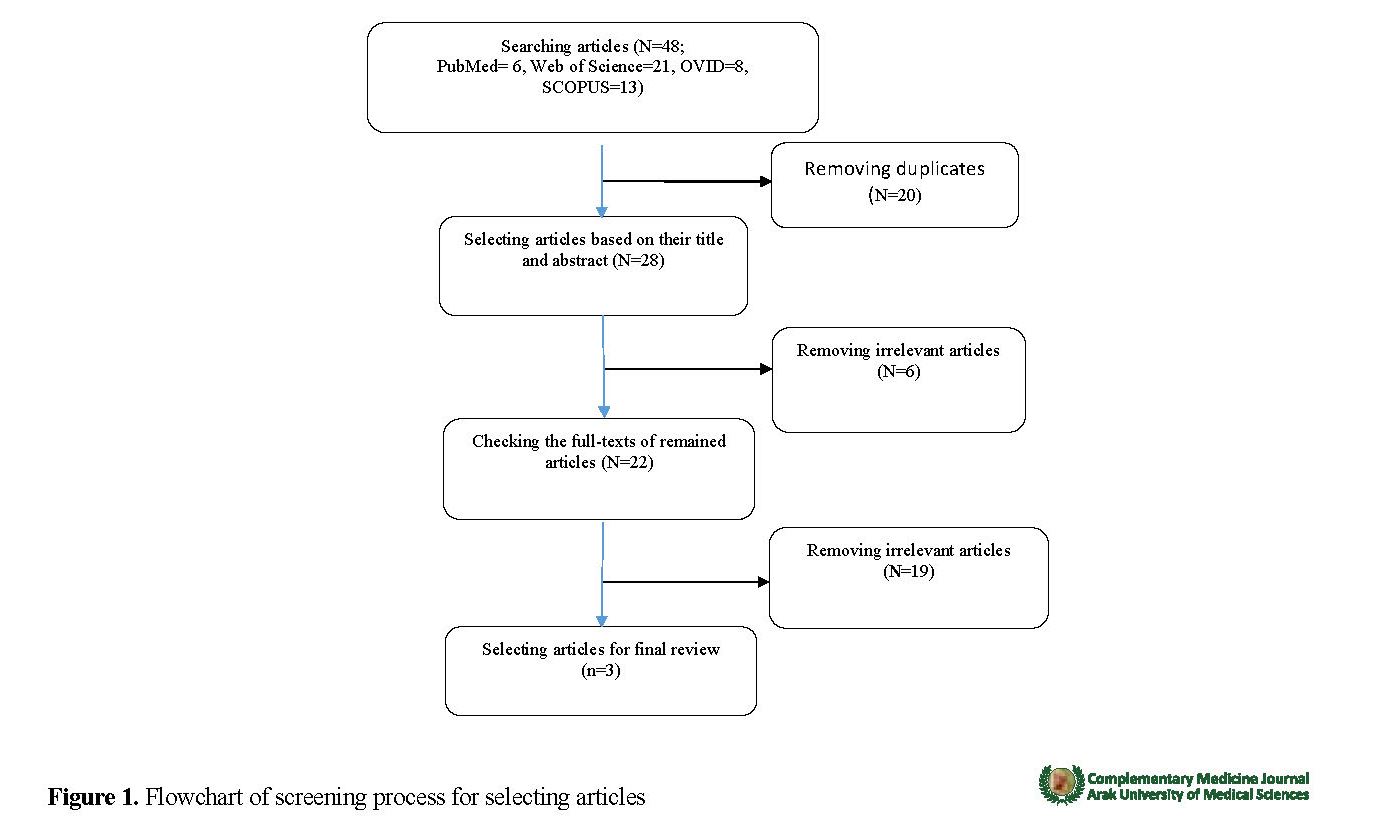Extended Abstract
1. Introduction
In developing countries, the incidence of Helicobacter pylori (H. pylori) is 70-80%, while in developed countries it is about 13-50 % of the population [2]. Pharmacological treatment of Helicobacter pylori infection is based on the use of at least two antibiotics with a double dose of proton pump inhibitor. The problem with eradication treatment is the sudden increase in H. pylori’s resistance to antibiotics. It seems that the use of herbal compounds reduces the side effects of drugs and causes their better efficiency [5]. The high anti H. pylori activity of Broccoli, Sulforaphane has been shown in in-vitro studies [6]. The aim of this study was to conduct a systematic review of randomized clinical trials that examined the effect of broccoli on human H. pylori infection.
2. Materials and Methods
In this systematic review, searching was conducted in PubMed, OVID, web of science, and Scopus databases using keywords: Helicobacter pylori, Broccoli sprout, H. pylori, Brassica, and Randomized clinical trial on articles in English published until January 2019. After searching, duplicate articles were deleted. The titles and abstracts of the articles were evaluated by two independent individuals and related articles were selected. Acceptable studies should be of a randomized clinical trial. They should not be in the laboratory or animal testing phases and should have available full text. The full texts of the related articles were then read and the final articles were selected. Figure 1 illustrates the screening process. The information of each study, including the authors’ name, the country of study, the number of samples, the year of study, and the results of the study were summarized in Table 1.
3. Results
Initially, 48 studies were found by searching databases and using related keywords. After removing duplicate items, 21 studies were evaluated by examining their title and abstract. Finally, only three related studies with the desired criteria were selected for review. These studies were conducted from 2009 to 2015 in three countries: Korea, Japan and Iran (Table 1). In the study conducted by Chang et al. [12] on 89 patients randomly assigned to three treatment groups, broccoli sprout extract containing sulforaphane did not inhibit the H. pylori infection density.

Bahadoran et al. [13] in a study in Iran on 86 type 2 diabetic patients with positive H. pylori randomly assigned to three treatment groups, showed that Broccoli, despite a considerable effect, could not compete with the three-drug treatment. In another rstudy, Yanaka et al. [14] examined 48 H. pylori–infected patients in Japan randomly assigned to two groups. Their results showed that Broccoli could reduce H. pylori but could not completely eradicate it. Overall, neither in the articles that reviewed in the present study nor in the articles that did not enter the review process due to unavailability of their full-texts [8-10] or having a very small sample size [11], no clear effect of broccoli on inhibiting H. pylori infection had been reported.

4. Discussion
According to the present systematic review study, the consumption of broccoli has no therapeutic effect in controlling H. pylori infection. There are several biologically active compounds in broccoli, including carotenoids, phylloquinone, antioxidant vitamins, vitamins B1, B2 and selenium, but its main bioactive compound that is responsible for its beneficial effects is sulforaphane [15]. The beneficial effects of this compound on eradication and improvement of the complications of H. pylori infection have been shown in several cellular and animal studies. sulforaphane has a inhibitory effect on H. pylori in human epithelial cells [16].
Studies have shown that the gastric microbiota (e.g. Clostridium spp) affects the severity of H. pylori infection [20]. The reviewed study had not been addressed this issue. The degree of antibiotic resistance of individuals before the study can also affect the results. In the reviewed studies, broccoli extract, powder and sprouts were used in different doses, which in turn can affect the concentration of sulforaphane and other active ingredients of broccoli [21] and have different results on the eradication of H. pylori infection.
5. Conclusion
Looking more closely at the studies, it seems that the reason for not seeing the desired result of broccoli in controlling the H. pylori infection is related to the difference in the severity of infection with this bacterium, dose and type of the used broccoli, the duration of study , the use or non-use of concomitant standard treatment, and insufficient sample size. Due to the lack of optimal results from broccoli consumption for the control of H. pylori infection in humans, it is recommended that longer studies with sufficient sample size and appropriate dose of broccoli, along with standard treatment be performed in the future.
Ethical Considerations
Compliance with ethical guidelines
This is a review article with no human or animal specimens and no need for ethics code.
Funding
Arak University of Medical Sciences financially supported this study.
Authors' contributions
All authors contributed in preparing this paper.
Conflicts of interest
The authors declare no conflict of interest
Acknowledgements
The authors would like to thank Arak University of Medical Sciences for their financial support and cooperation.
